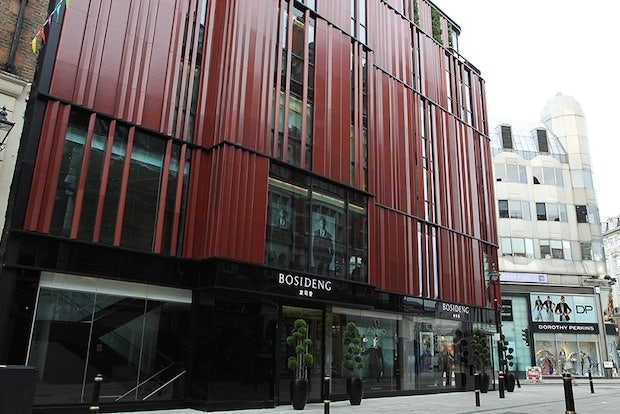
Chinese down coat company Bosideng made the list of China's top 100 brands this year. (Bosideng)
There’s no doubt that there are some truly massive Chinese brands that are likely set to grow to even more enormous proportions in the years to come, but when it comes to Chinese luxury companies, most still lag behind international giants. A new report by Millward Brown that assesses the top 100 Chinese brands pulls names from all sectors, and shows that luxury brands are decidedly sparse on the list in comparison to other industries, such as tech.
However, there were certainly more Chinese brands with luxury-related offerings this year than last—mainly in the alcohol, jewelry, and hotel categories. In addition, more apparel was on the list this year, including Bosideng, a down coat company that opened a store in London in 2012.
In addition to the list of brands, the report also features advice on how Chinese companies can strategize to gain more success in the future. Below are some of the main pieces of advice offered by the report that could help more Chinese luxury brands make their way up the list—and foreign brands should take note as well.
Take advantage of enormous opportunities in smaller cities.#
Major international luxury brands have been expanding into China’s lower-tier cities, but their focus still remains squarely fixed on tier 1 or tier 2. However, the report states that third- and fourth-tier cities could offer opportunity to Chinese brands looking to gain a foothold in the market. According to the report, “Consumers of third- and fourth-tier cities are still at the initial stage of brand consumption, which is characterized by a strong desire to consume, but a lack of brand knowledge. Brand loyalty tends to be low.” In order to take advantage of this situation, brands should leverage synergies with economically and culturally similar city clusters, act as “role models” for consumers, cultivate local grassroots brand ambassadors, and place focus on education about the brand.
Go global.#
The report notes that most Chinese brands “are not known by overseas consumers,” but this situation “could soon change drastically.” Chinese brands are rapidly moving abroad, and while luxury may be behind other sectors, there are several things it can do to gain more international attention. In order for Chinese brands to succeed internationally, “both ‘Brand China’ and individual Chinese brands have to cultivate stellar images,” says the report. “Overseas consumers, who are not familiar with a country’s brands/products, tend to infer quality from the country’s image.” So how can “Brand China” receive a boost when it comes to luxury? The report suggests that it take a page from Europe’s playbook by conveying an image of expertise in certain products, like France does for perfume or Switzerland does for watches.
Embrace e-commerce.#
China’s e-commerce market may be young, but it’s already huge and growing rapidly—to put it in perspective, it’s “larger than the population of almost every other country, but it’s less than one-fifth of China’s population of over 1.3 billion,” says the report. There are some challenges inherent to conducting e-commerce in China, but brands can take several steps to foster success, including building product trust against a backdrop of rampant fakes, delivering first-class service, and making sure logistics planning accounts for the specific needs of lower-tier cities.
Challenge convention on social media.#
The report states that “80 percent of brands in Asia investing in social media are doing so to support content reach and awareness objectives,” but “only about half as many brands focus on sales or lead generation.” However, “the time is right to redress this balance,” it says. According to the report, brands should be working to innovate on China's top social media platforms such as WeChat in areas including using the scan feature for commerce, enabling location-based services, and providing personalized messages based on data from existing customer databases.
Leverage mobile.#
Mobile arrived as part of the “marketing mainstream” for brands in 2013 thanks to an explosion in the use of smartphones and the development of 3G, 4G, and Wi-Fi networks. “In China, mobile has become the primary route to the online world,” says the report. Mobile has value both in and out of the transactional space: it can not only be used to influence purchasing behaviors on e-commerce channels, but can also be valuable for ad space as mobile becomes an increasingly important media consumption tool. “To employ mobile effectively, marketers must recognize that phones and tablets are incredibly personal devices that consumers use in very diverse ways,” says the report. “Mobile has no one role in peoples’ lives or in consumers’ paths to purchase.”